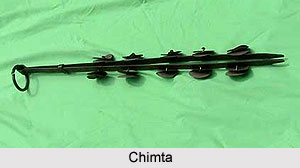 Chimta is a percussion instrument used in Punjab folk music and it literally means tongs. Over time it is seen that this instrument has evolved as traditional percussion instrument of South Asia by the permanent addition of small brass jingles. This is an instrument which is also quite popular in various folk songs and dances of Punjab - Bhangra music and the Sikh religious music known as Gurbani Kirtan.
Chimta is a percussion instrument used in Punjab folk music and it literally means tongs. Over time it is seen that this instrument has evolved as traditional percussion instrument of South Asia by the permanent addition of small brass jingles. This is an instrument which is also quite popular in various folk songs and dances of Punjab - Bhangra music and the Sikh religious music known as Gurbani Kirtan.
The people who play Chimta is able to produce a chiming sound if he holds the joint of the instrument in one hand and also strikes the two sides of Chimta together. The jingles are actually made of metal and are thus helpful in producing metallic sounds and also help to keep up the beat of the songs. In weddings or in case of Bhangra music, it is often combined with the Bhangra dancers and Dhol.
Design and Construction of Chimta
Chimta is a type of traditional instrument which is needed for Punjabi folk music. It consists of long, flat piece of steel or iron that is pointed at both ends and folded over in the middle. A metal ring is also attached near the fold and there are jingles or rings that are attached along the sides at regular intervals.
Sometimes there are seven pairs of jingles and the rings are plucked in a downward motion to produce tinkling sounds. Chimtas with large rings are also used at rural festivals while ones with smaller rings are often used as accompaniment to Bhangra dancers and singers of traditional Indian hymns.
Notable Players of Chimta
There are many popular names that play this instrument - Chimta. One among the popular names is Alam Lohar who has introduced this instrument to the global audience. Presently, musicians like Kamal Heer and Arif Lohar play this instrument. Also known as the "rusty tambourine sword", the Chimta has been played by members of the experimental rock band His Name Is Alive on recent tours
This article is a stub. You can enrich by adding more information to it. Send your Write Up to content@indianetzone.com




















